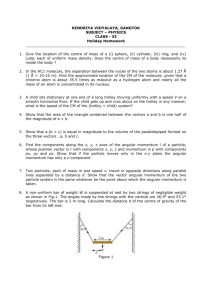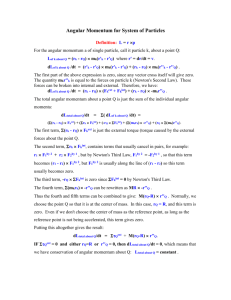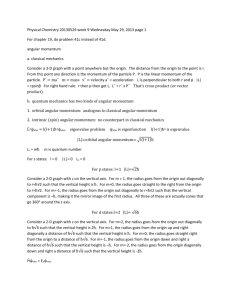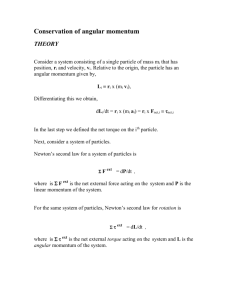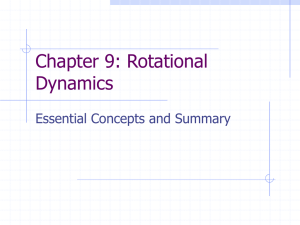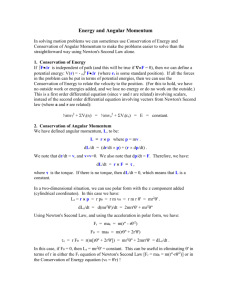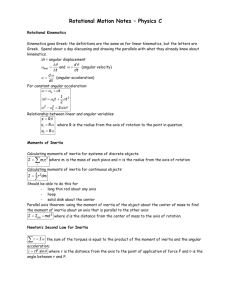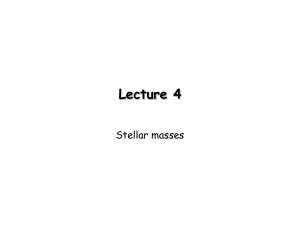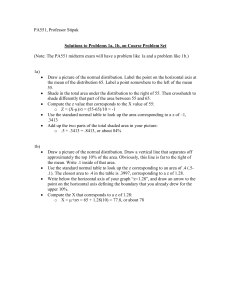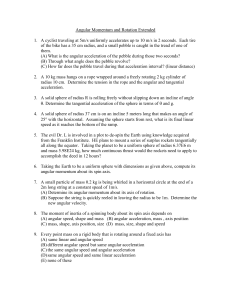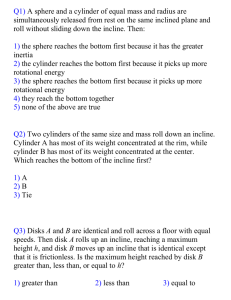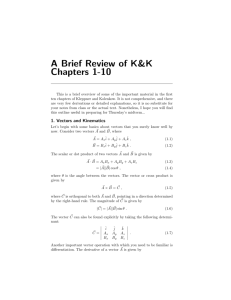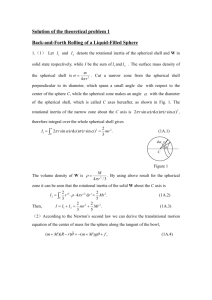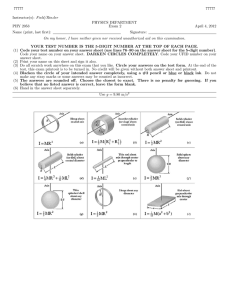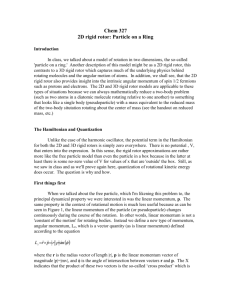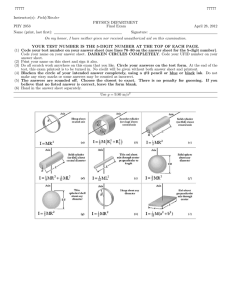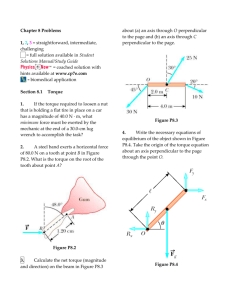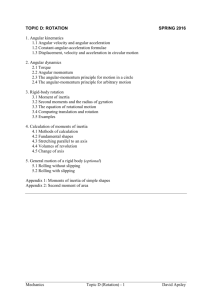Chapter 1 Quick Review
advertisement
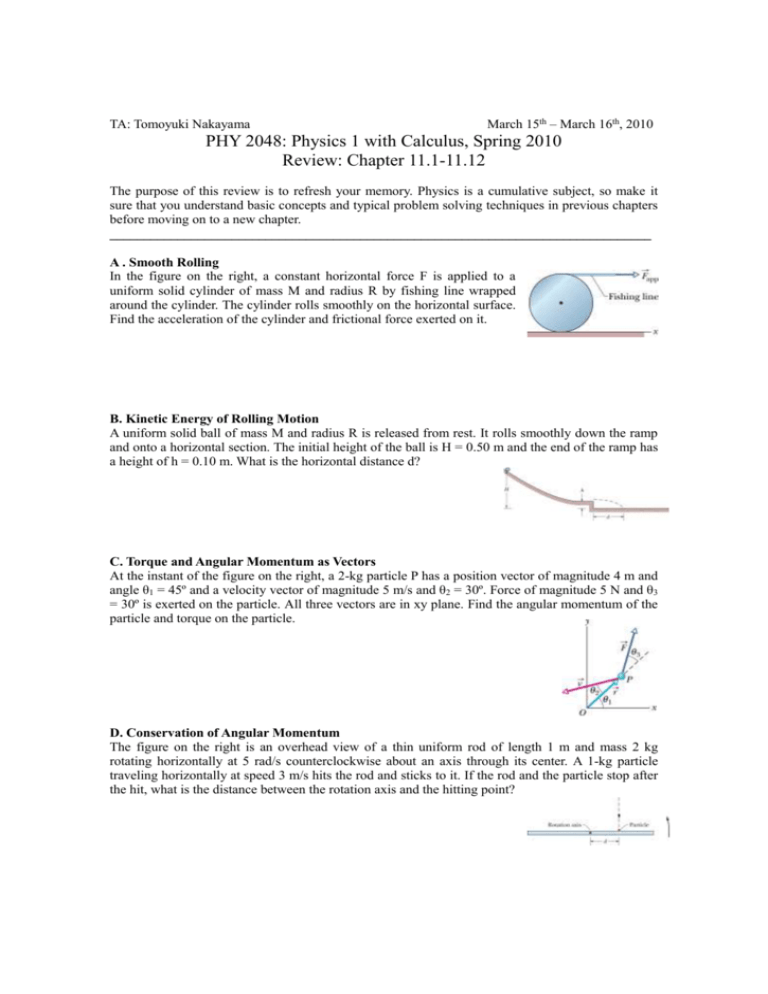
TA: Tomoyuki Nakayama March 15th – March 16th, 2010 PHY 2048: Physics 1 with Calculus, Spring 2010 Review: Chapter 11.1-11.12 The purpose of this review is to refresh your memory. Physics is a cumulative subject, so make it sure that you understand basic concepts and typical problem solving techniques in previous chapters before moving on to a new chapter. ________________________________________________________________________________ A . Smooth Rolling In the figure on the right, a constant horizontal force F is applied to a uniform solid cylinder of mass M and radius R by fishing line wrapped around the cylinder. The cylinder rolls smoothly on the horizontal surface. Find the acceleration of the cylinder and frictional force exerted on it. B. Kinetic Energy of Rolling Motion A uniform solid ball of mass M and radius R is released from rest. It rolls smoothly down the ramp and onto a horizontal section. The initial height of the ball is H = 0.50 m and the end of the ramp has a height of h = 0.10 m. What is the horizontal distance d? C. Torque and Angular Momentum as Vectors At the instant of the figure on the right, a 2-kg particle P has a position vector of magnitude 4 m and angle θ1 = 45º and a velocity vector of magnitude 5 m/s and θ2 = 30º. Force of magnitude 5 N and θ3 = 30º is exerted on the particle. All three vectors are in xy plane. Find the angular momentum of the particle and torque on the particle. D. Conservation of Angular Momentum The figure on the right is an overhead view of a thin uniform rod of length 1 m and mass 2 kg rotating horizontally at 5 rad/s counterclockwise about an axis through its center. A 1-kg particle traveling horizontally at speed 3 m/s hits the rod and sticks to it. If the rod and the particle stop after the hit, what is the distance between the rotation axis and the hitting point? TA: Tomoyuki Nakayama March 15th – March 16th, 2010 PHY 2048: Physics 1 with Calculus, Spring 2010 Practice Exam Problems (Chapter 11.1-11.12) Working on this problem set is optional, but it is strongly recommended. It is highly likely that some of these problems will appear in the exams. Do it on a weekly basis. Cramming is tiring and sometimes it ends up in a disaster. ________________________________________________________________________________ 1. A solid wheel of mass M, radius R, and rotational inertia MR2/2, rolls without sliding on a horizontal surface. A horizontal force F is applied to the axle and the center of mass has an acceleration a. The magnitudes of the applied force F and the frictional force f of the surface, respectively, are: (Rolling Motion) a. F = Ma, f = 0 b. F = Ma, f = Ma/2 c. F = 2Ma, f = Ma d. F = 2Ma, f = Ma/2 e. F = 3Ma/2, f = Ma/2 2. A thin-walled hollow tube rolls without sliding along the floor. The ratio of its translational kinetic energy to its rotational kinetic energy (about an axis through its center of mass) is: (Kinetic Energy of Rolling Motion.) a. 1 b. 2 c. 3 d.1/2 e. 1/3 3. A 2.0-kg block starts from rest on the positive x axis 3.0 m from the origin and thereafter has an acceleration given by a = (4.0 m/s2)i-(3.0 m/s2)j. The torque, relative to the origin, acting on it at the end of 2.0 s is: (Torque as a Vector) a. 0 b. (-18N m)k c. (+24 N m)k d. (-144 N m)k e. (+144 N m)k 4. A uniform disk, a thin hoop, and a uniform sphere, all with the same mass and same outer radius are each free to rotate about a fixed axis through its center. Assume the hoop is connected to the rotation axis by light spokes. With the objects starting from rest, identical forces are simultaneously applied to the rims, as shown. Rank the objects according to their angular momenta after a given time t, least to greatest. (Eqn of Motion in Angular Form) a. all tie b. disk, hoop, sphere c. hoop, disk, sphere d. hoop, sphere, disk e. hoop, disk, sphere 5. As a 2.0-kg block travels around a 0.50-m radius circle it has an angular speed of 12 rad/s. The circle is parallel to the xy plane and is centered on the z axis, 0.75 m from the origin. The magnitude of its angular momentum around the origin is: (Angular Momentum) a. 6.0 kg m2/s b. 9.0 m2/s c. 11 m2/s d. 14 m2/s e. 20 m2/s 6. A playground merry-go-round has a radius of 3.0 m and a rotational inertia of 600 kg m2. It is initially spinning at 0.80 rad/s when a 20-kg child crawls from the center to the rim. When the child reaches the rim the angular velocity of the merry-go-round is: (Conservation of Angular Momentum) Answers: 1-e 2-a 3-b 4-a 5-c 6-a
